MUNDUS, BLUMEN Meisterwerke der Natur in Bildern der Kunst
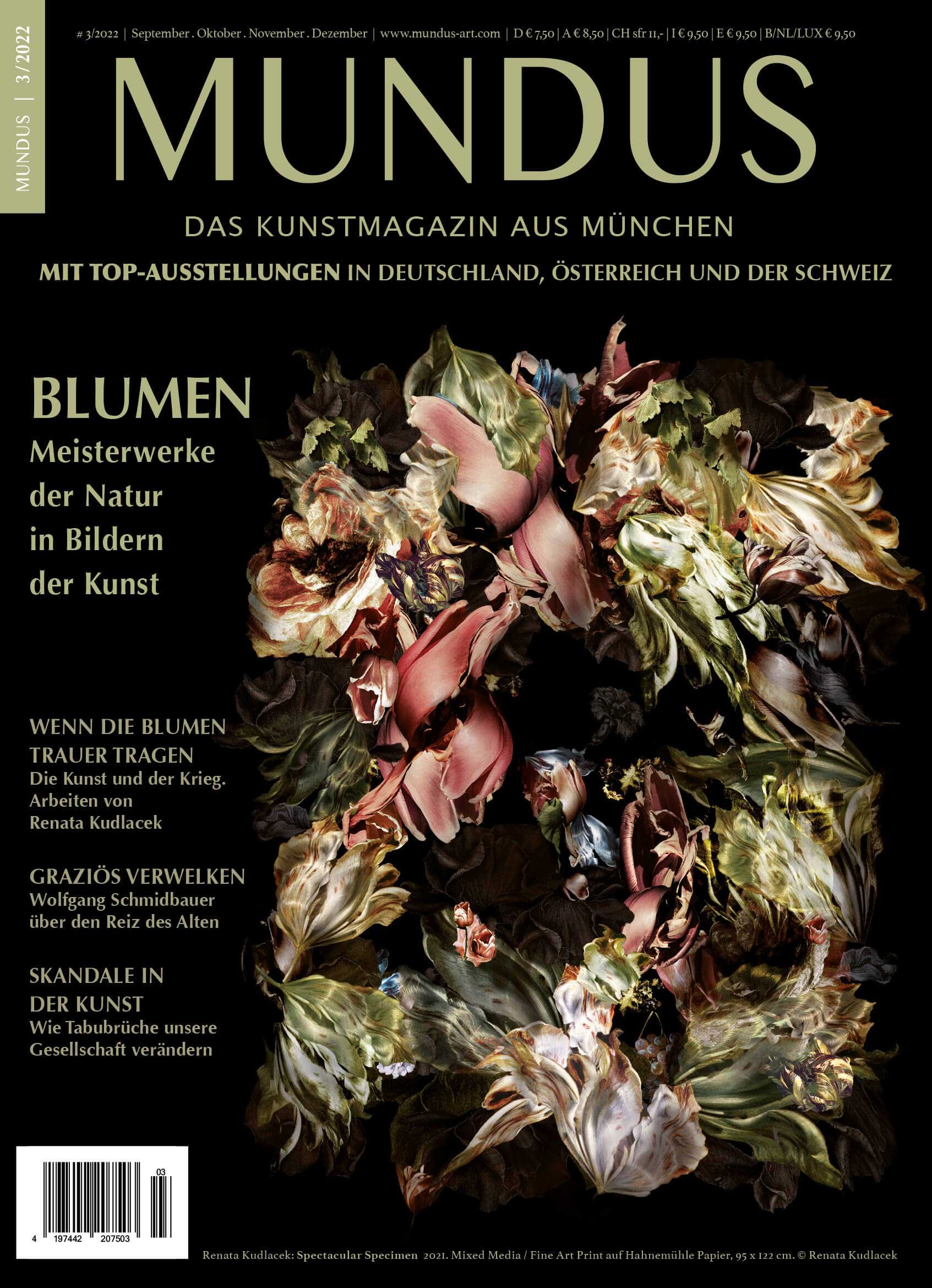
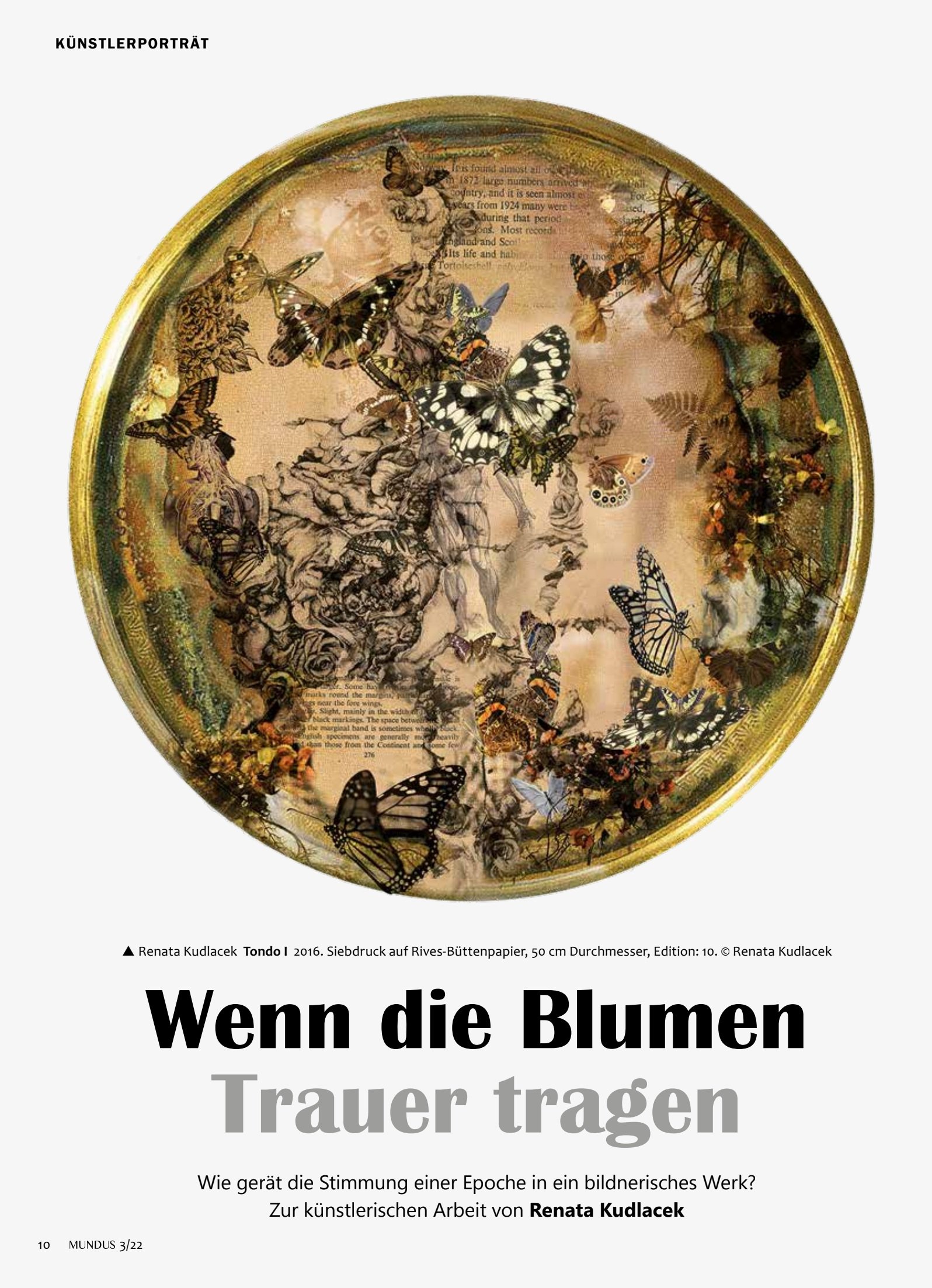
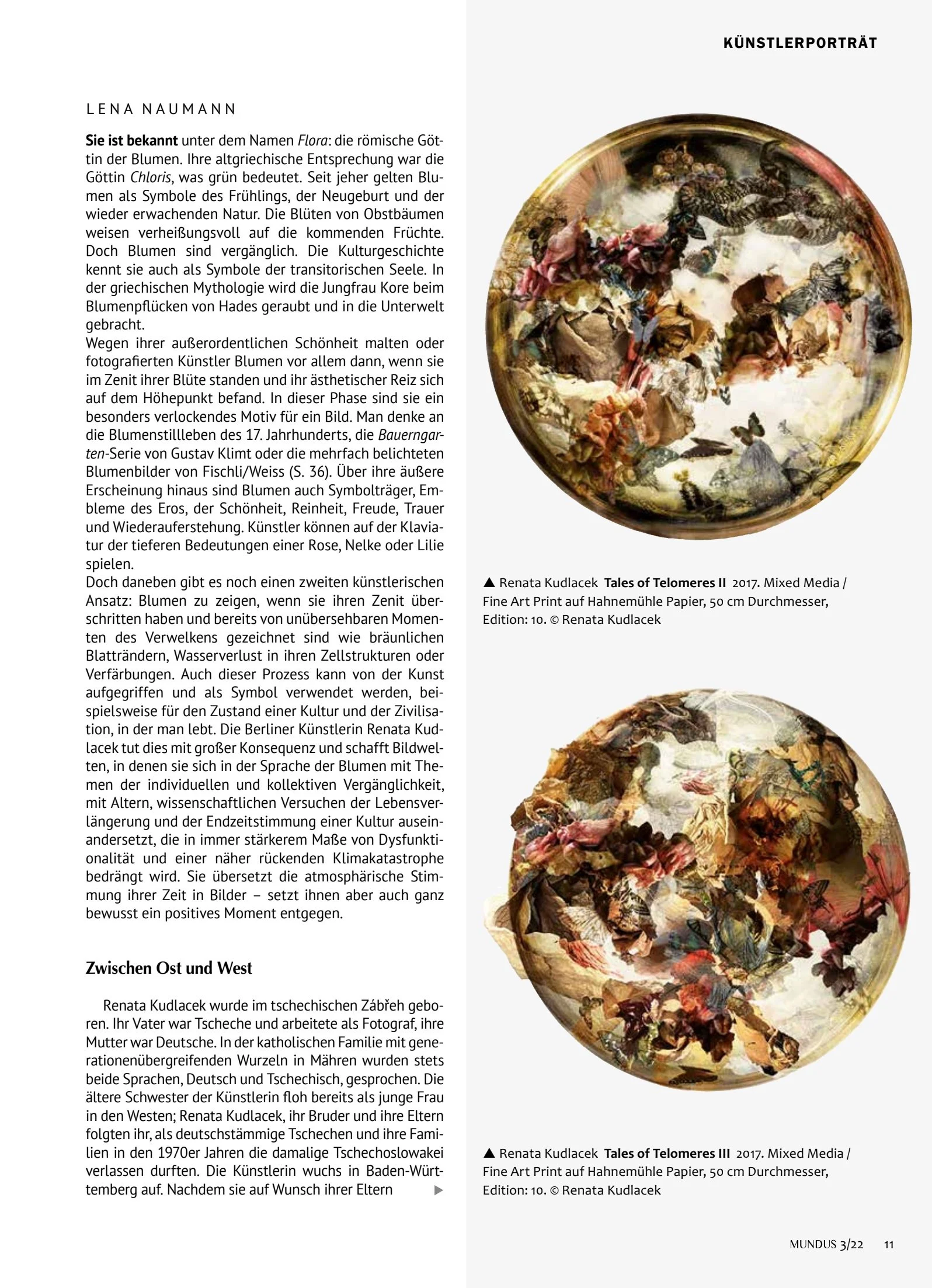
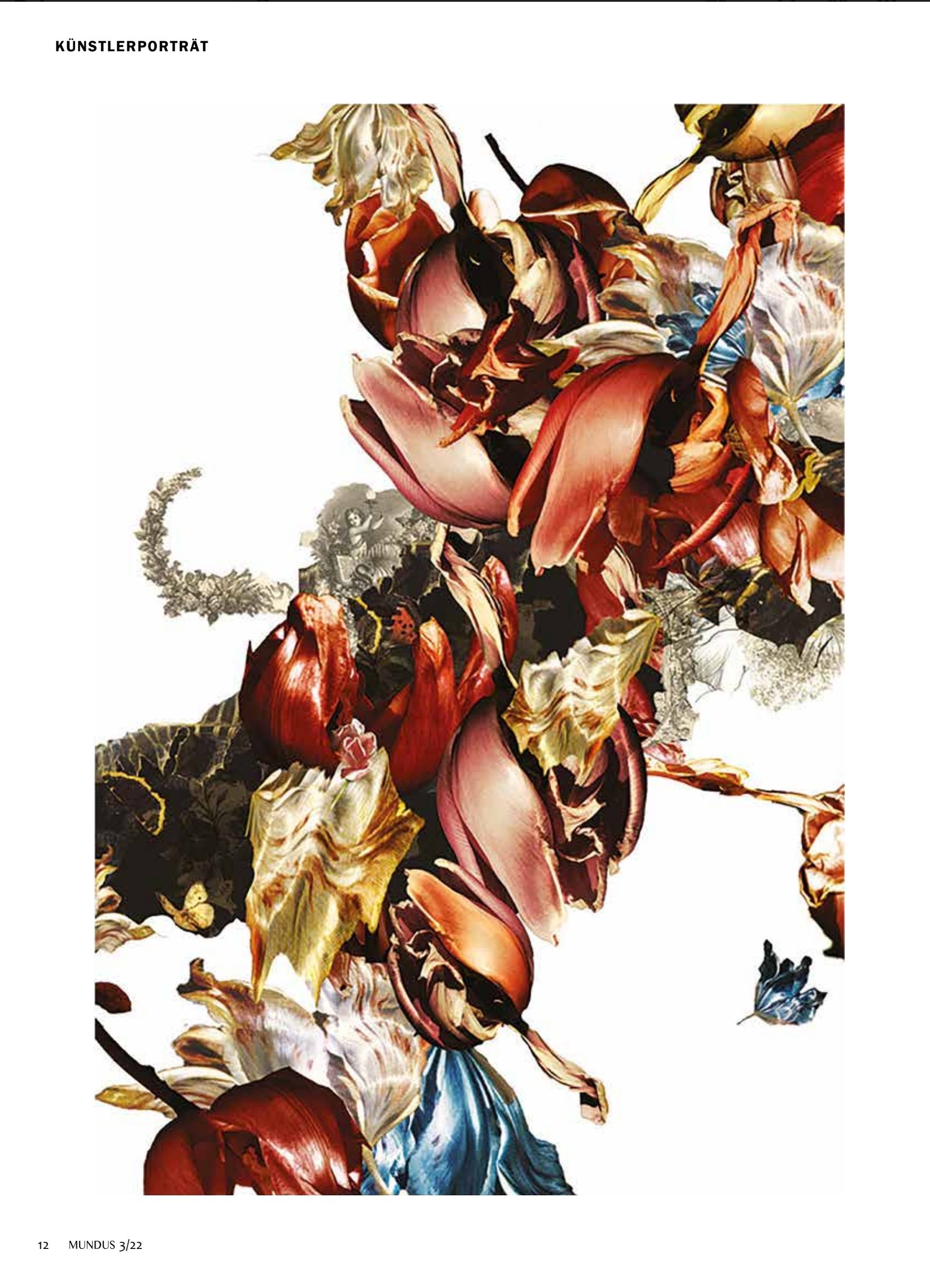
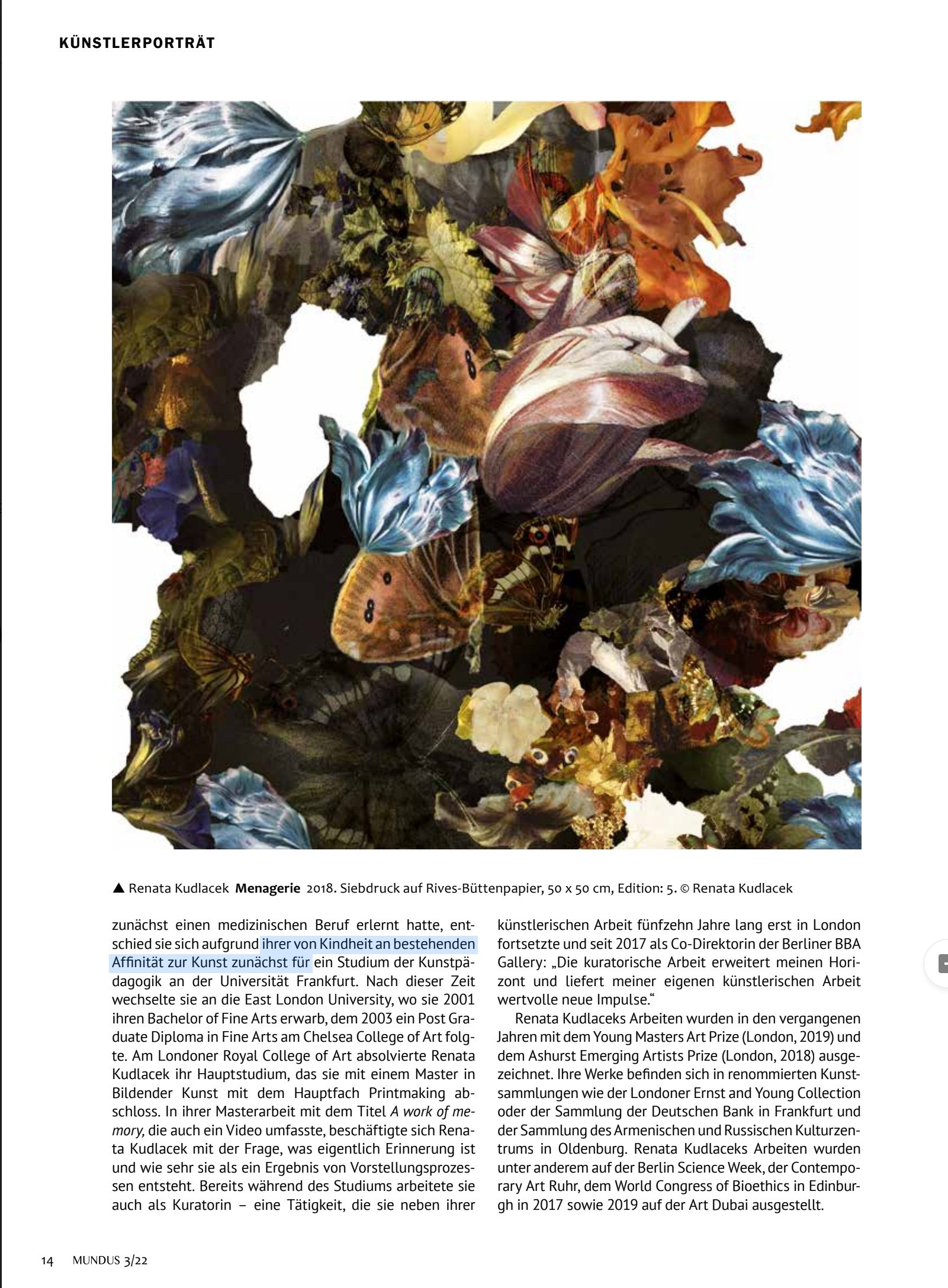
English version - translated from German:
Wenn die Blumen Trauer tragen
WHEN THE FLOWERS BEAR MOURING
How does the mood of an era find its way into a pictorial work? On the artistic work of Renata Kudlacek
LENA NAUMANN
She is known as Flora: the Roman goddess of flowers. Her ancient Greek equivalent was the goddess Chloris, associated with green. Since time immemorial, flowers have been considered symbols of spring, rebirth and the reawakening of nature. The blossoms of fruit trees point auspiciously to the forthcoming fruits. But flowers are transient. Cultural history also knows them as symbols of the transitory soul. In Greek mythology, the virgin Kore is stolen by Hades while picking flowers and taken to the underworld.
Because of their extraordinary beauty, artists painted or photographed flowers especially when they were at the zenith of their bloom and their aesthetic appeal was at its peak. At this stage, they are a particularly appealing subject for a painting. Think of the flower still lifes of the 17th century.
These include the paintings of the nineteenth century, the Farmer's Garden series by Gustav Klimt or the multiple-exposure flower paintings by Fischli/Weiss (p. ...). Beyond their outward appearance, flowers are also symbol bearers, emblems of Eros, beauty, purity, joy, mourning and resurrection.Artists can play creatively on the the deeper meanings of a rose, carnation or lily..
But there is also a second artistic approach to it: to show flowers after they have already passed their zenith and are marked by unmistakable moments of wilting such as brownish leaf edges, loss of water in their cell structures or discoloration. This process can also be taken up by art and used as a symbol. A symbol for the state of a culture and the civilisation in which one lives. The Berlin artist Renata Kudlacek does this with great consistency and creates pictorial worlds in which she uses the language of flowers to deal with themes of individual and collective transience, aging, scientific attempts to prolong life and the end-of-life mood of a culture that is increasingly beset by dysfunctionality and an approaching climate catastrophe. She translates the atmospheric mood of our time into images - but also deliberately counters them with a positive moment.
Between East and West
Renata Kudlacek was born in Zábřeh, Czech Republic. Her father was Czech and worked as a photographer, her mother was German. Both languages, German and Czech, were always spoken in the Catholic family with intergenerational roots in Moravia. The artist's older sister fled to the West as a young woman; Renata Kudlacek and her parents followed her when Czechs of German origin and their spouses were allowed to leave what was then Czechoslovakia in the 1970s. The artist grew up in Baden-Württemberg. After medical studies at her parents' request, she decided to follow her affinity for art from childhood and began studying art education at the University of Frankfurt. After this time, she transferred to East London University in 2001, where she obtained her Bachelor in Fine Arts, followed by a Post Graduate Diploma in Fine Art at Chelsea College of Art in 2003. At London's Royal College of Art, Renata Kudlacek completed her advanced studies, graduating with a Master's degree in Fine Arts with a major in Printmaking. In her Master's thesis entitled A Work of Memory, which also included a video, Renata Kudlacek dealt with the question of the meaning of memory and how it is a result of imaginative processes. Already during her studies, she also worked as a curator - an activity she continued alongside her artistic work for fifteen years, first in London and since 2017 as co-director of the Berlin BBA Gallery: "Curatorial work broadens my horizons and provides valuable new impulses for my own artistic work."
Renata Kudlacek's work has been awarded the Young Masters Art Prize (London, 2019) and the Ashurst Emerging Artists Prize (London, 2018) in recent years. Her works are held in renowned art collections such as London's Ernst and Young Collection, Deutsche Bank Collection in Frankfurt and the Armenian and Russian Cultural Center Collection in Oldenburg. Renata Kudlacek's works have been exhibited at Berlin Science Week, Contemporary Art Ruhr, the World Congress of Bioethics in Edinburgh in 2017 and at Art Dubai in 2019, among others.
Collages with multiple references
The starting point for her highly aesthetic, but also melancholic and enigmatic pictures is a collection of thousands of texts, photos, books and sketches that she herself created over many years, including an almost incalculable abundance of flower images in the form of her own photographs and drawings. They are the base material that Renata Kudlacek processes on the computer depending on the theme of the respective series and assembles it into a work. Once the work is completed, she prints the picture by hand - usually in an edition of five to ten copies - using the screen-printing process on handmade Hahnemühle paper or using the mixed media technique.
Renata Kudlacek's paintings are collages. For example in the Tondo series she uses flower petals, tree leaves, writings from old books, photographs and drawings of intestines and other parts of the human anatomy, parts of skin that have been perfused or photographs of DNA structures. The word tondo comes from the Italian rotondo and means round. The Renaissance used this term for circular images. In the same way, however, a desco da parto, a so-called birth plate for the afterbirth, but also the stillbirth of a woman was called, whereby these wooden plates developed into a memento mori symbol. However, they were also often painted and in the late Middle Ages became a symbolic gift for a successful birth. A tondo thus symbolizes birth and death, new beginnings and endings, at the same time. Its round shape can be found in modern times when looking into a microscope or a petri dish. Accordingly, Renata Kudlacek works with elements such as the structures of a DNA as a symbol for new life as well as the butterfly, which, due to its emergence from a cocoon, is both a symbol for perpetual transformation and renewal - one of the most poetic images for the self-renewal of the psyche - and a symbol for the soul of a dead person when it leaves the body.
Her second series, Tales of Telomeres, created in recent years, emerged from an engagement with scientists as part of the Art and Ethics research project at Edinburgh University in 2017, in which artists and scientists worked together to scientifically investigate or artistically express cellular degeneration, the process of aging and medicine's attempts to prolong life. Telomeres, the protective caps at the ends of chromosomes, shorten with each cell division, which increasingly limits the functioning of cells until organs and organisms die. Science is trying to reverse this process. What ethical and social questions would arise if people lived many decades longer than is currently possible? In her series of telomere stories, Renata Kudlacek explores these questions associatively. In the circular pictures, one discovers foods such as grapes and the organs important for their utilization, such as the stomach or intestinal loops; one finds a human brain fluttered around by numerous butterflies, dreaming of immortality, or the snake, which appears in the myths of peoples as much as a cosmic creator as a destroyer and thus symbolizes the process of telomeres destroying humans by shortening them, as well as the hope of science to preserve life through a constant regeneration of telomeres.
With her series Metamorphoses Renata Kudlacek was inspired by her visit to London, where a sea of tulips had been laid out in front of St Paul's Cathedral. In this series, tulips flowing into each other dominate. In the metamorphoses, their leaves continuously intertwine and embrace each other, fighting with each other and giving rise to something new. In this way, they carry out an intrinsic process of life - for the artist very personally also the merging of her old home in London, where she lived for a decade and a half, with her new home in Berlin. Since the tulip mania in the 17th century, the first stock market crash in history, few other plants have undergone such a strong metamorphosis of meaning as this plant: in Turkish culture, tulips used to be considered a symbol of paradise on earth and almost had a divine status, while in the Netherlands they symbolized the brevity of life. Flowing and changing processes can be aptly reflected in the tulip, because unlike other flowers such as the coneflower or the lotus, tulips can genetically reinvent themselves again and again to change their aesthetics to quasi-feathered and mottled petals. The Metamorphoses series alludes to the enormous mutability of this flower, which in Christianity symbolizes faith and love. With the Metamorphoses, Renata Kudlacek also ties in with the content of her master's thesis A work of memory: our imagination is capable of change. It leads to a change and fusion of images. Without imagination there are no imaginative processes - and these are subject to a perpetual metamorphosis, because imagination is never static.
The artist continues the still life theme in the Menagerie series. The genre term still life encompasses the painterly depiction of motionless objects such as flowers, fruits, dead animals, glasses or instruments, which are arranged not only according to aesthetic, but often according to content-related and symbolic aspects. The genre developed mainly in the 17th century and is also known under the French name nature morte. Renata Kudlacek was inspired to create this series by a visit to the exhibition Das geheimnisvolle Leben zu unseren Füßen (The Mysterious Life at Our Feet) 2017 at the Staatliches Museum Schwerin, which was dedicated to the forest floor still lifes of the 17th-century Amsterdam painter Otto Marseus van Schrieck. In the Menagerie series, Renata Kudlacek is inspired by the tension between the realistic representation and the deeply symbolic content of typical still-life objects, as well as by the tension between life and death, movement and stillness. Mushrooms and onions, snails, turtles and butterflies interact; what is new is that they do not do so in the usual static, "posed" way, but Renata Kudlacek lets her still life elements float and flow, as it were. In this way, they form a coherent artistic continuity with the Metamorphoses series. The element of flow is also repeated in the four-meter-long work Quest to Bloom, which was created during the Corona pandemic. Quest to Bloom expresses a never-ending longing for that vitality that was massively blocked for everyone by the multiple restrictions during the pandemic period. The floating fragments, garlands and creatures are of this world, complex and sensual. The artist mixes fragile, lovely forms with a rich, baroque color palette. Quest to Bloom expresses the longing for the myth of Eden, for a paradise on earth that has fascinated generations of people since time immemorial. Quest to Bloom finds its continuation and intensification in the latest and current series Spectacular Specimen - here the delights of the garden, not only the paradisiacal ones, are celebrated. The series is inspired by the tales of idyllic garden landscapes in the myths of the Orient, of fertile and peaceful oases that God created as homes for man. The flower and fruit wreaths of Spectacular Specimen are slightly rectangular in shape - an allusion to the ancient Iranian idea of paradise as an enclosed park. For paradise to remain a paradise, it needs boundaries. The motifs in this series have - and this is new - a deep black background. They leap powerfully at the viewer from this darkness; he is virtually overwhelmed by what comes to him from these depths.
What is the value and contemporaneity of these paintings? The artist's series mentioned were created in the period from 2014 to the present. They cannot be comprehensively understood without reflecting on what has happened during this time. Putin's first attack on Ukraine was already highly traumatic for people who have their family roots in Eastern Europe. It activated all the horrors from the time when countries like Czechoslovakia were still under the rule of the USSR. The current Ukraine war in 2022, the bestial actions of Putin and his soldiery towards Ukrainians, is even harder to bear for people in Eastern Europe than for citizens of the former West. In such times, artists cannot paint cheerful, colorful flower pictures. Renata Kudlacek's flowers look autumnal; they are about to wither for good. They radiate the same melancholy and sadness that people feel in the face of the horrors of the recent war, but also in the face of an escalating climate catastrophe and the growing doubts as to whether it can still be overcome. And yet the artist does not stop at melancholy, but counters it with something: the pictures remain magnificent and lush, almost baroque. They seem poured out as if from a cornucopia and backlit as if a light shines through them. Their message is: man can always counter suffering and decay with something. It is the beauty and the light of consciousness that - as in the life cycle of flowering plants - create a new spring after every winter.
